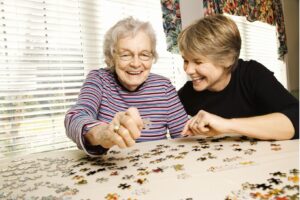Most of us are familiar with the boomerang generation—kids in their 20s and 30s moving back home with their parents due to rising housing costs and limited jobs. Especially in attractive, urban cities like San Francisco, many people—both young and old alike—are being priced-out. And now, with life expectancy increasing, and many people currently living into their nineties and beyond, a reverse trend is happening: aging parents are moving back in with their adult children. Older adults are becoming the new boomerang generation—and, for many families, the trend makes wonderful sense.
The benefits of pooling resources and having in-home support mean that multigenerational homes are becoming increasingly popular each year. For the past 10 years in the UK, there’s been a 50% rise in the number of multigenerational families living in the same house. For families with both elderly parents and older adults, living together (or at least near one another) may offer a level of support, connection, and comfort not found when living alone.
Why Multigenerational Homes Are a Big Trend
Multigenerational homes are becoming a new norm, but the reason for this upwards trend may vary between families, including:
- Rising housing prices, particularly in urban locations like the Bay Area
- Wanting to provide care and support for an aging loved one
- Being unable to afford a nursing home or full-time private care
- Wanting to spend more time with family members
- Aging parents who prefer to live with family rather than in a care facility
- Sharing the costs of living, from utilities to grocery bills, to ease financial stress
The Many Benefits of Multigenerational Living
Living together under one roof offers a myriad of benefits to all generations of a family—here are a few of note if you’re considering communal living with an aging loved one.
Provides Daily Socialization for All Members of the Household
Many older adults find they’re prone to isolation when living alone—and this can lead to depression, anxiety, and other mental health issues. Living communally, on the other hand, offers many more social opportunities. Each member of the family can enjoy daily interaction with their loved ones, including the emotional support that comes with it.
A recent study showed that, generally speaking, “people living alone have fewer close ties with relatives and fewer acquaintances” and “are less likely to be satisfied with the size of their networks.” But, whether you and your aging loved one live in the same household, or in neighboring complexes of an assisted living facility, spending time together each day can nip isolation, and its related illnesses, in the bud.
Reduces Costs—and Stress
Consolidating resources means opening up opportunities that may otherwise be impossible, like affording a bigger house or pursuing leisure activities. It can also help to reduce the burden of financial stress surrounding daily necessities that can increase when living alone. Alternative situations, like nursing homes or hiring a caregiver to support an aging loved one living independently, can be quite costly—and don’t offer the social and emotional benefits of a multigenerational home.
Easier for Family and Friends to Visit
As we get older, visits from loved ones only become more precious. Yet, it can be difficult for extended family members or close friends who don’t live in the same area to spend quality time with one another. Loved ones often live in different cities, have busy lives of their own, and simply struggle to find time to connect amidst the daily grind. But, when several family members live in one house (or in close proximity), it creates extra incentive for loved ones from outside the local area to visit more often.
Makes Caretaking More Efficient
Having access to quality care is so important as we age. A multigenerational household enables older adults to flexibly care for their aging parents at home—they can offer as much help as their own schedule allows, while hiring additional assistance as needed. Older adult children may also begin to need some level of support, and can share the same caregiver as their aging parents, cutting down on efforts to find a good caregiver—and in many cases establishing a stronger bond between the caregiver and the family.
Offers Intergenerational Lessons for All
Learning and loving is what being part of a family is all about. Living together can be eye-opening and rewarding for each generational in different ways: older adults can offer invaluable help to their elderly parents by caring for them, and can absorb first-hand insight into what their upcoming stage of life is really like.
Meanwhile, elderly parents benefit from the care their kids, and possibly grandkids, provide, while getting to once again be a part of their loved ones’ daily lives. Each generation has something invaluable to teach the other. With the right attitude, a multigenerational home can become a place for observation, reflection, and gratitude.
A close connection with family members is one of life’s greatest joys. Sharing small, everyday moments of joy, like cooking together and laughing at silly jokes, is something you and your aging loved ones can cherish forever. Meanwhile, for older adults looking to spend quality time with their aging parents in a financially-sustainable setting, a multigenerational living arrangement can be the perfect solution.
While living with multiple generations in one home might not work for every family, there are other ways to create similar benefits, like living closer to one another in the same city, moving to a retirement community together, or renting several apartments in one building. Staying open to alternative ways of living can help you and your loved ones enjoy a high quality of life while sharing one another’s company. At the end of the day, it’s the relationships you build with one another that are truly meaningful—and sharing a home is a wonderful way to embrace this sense of togetherness.
If you want to provide better support to your aging loved one, Institute on Aging offers a variety of services, programs, and online resources. Contact us today to discover more.







